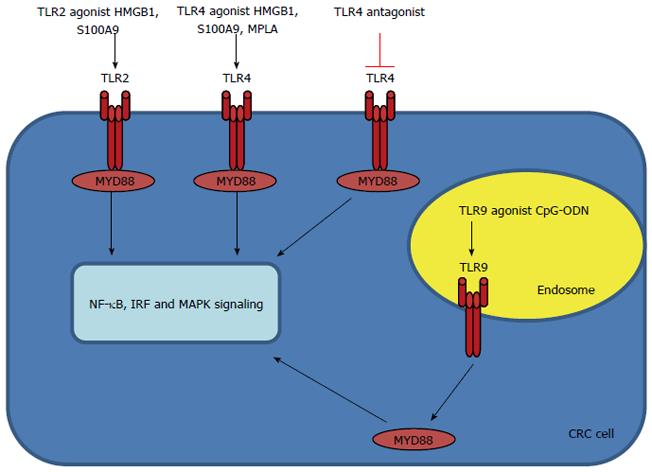Copyright
©2014 Baishideng Publishing Group Inc.
World J Gastroenterol. Dec 21, 2014; 20(47): 17699-17708
Published online Dec 21, 2014. doi: 10.3748/wjg.v20.i47.17699
Published online Dec 21, 2014. doi: 10.3748/wjg.v20.i47.17699
Figure 1 Toll-like receptor signaling pathways.
There are 2 major toll-like receptor (TLR) pathways: One is mediated by myeloid differentiation factor 88 (MYD88) adaptor proteins, and the other is independent of MYD88. With the exception of TLR3, all other TLRs commonly use MYD88 as the downstream adapter protein. Activated TLRs recruit MYD88, leading to subsequent activation of the downstream targets. TLR2 and TLR4 combine with their respective ligands to form dimeric complexes and change their configuration, and then recruit specific adapters within cells, including MYD88, TIR domain-containing adaptor protein (TIRAP)/MYD88 adaptor-like (Mal), TIR domain-containing adaptor-inducing interferon (IFN)-β (TRIF) and TRIF-related adaptor molecule (TRAM). The subsequent activation of the IKK complex, consisting of TBK1/TRAF3/IKKε, NEMO/IKBKE, induces phosphorylation of IKBKE, leading to the activation of transcription factors. TLRs bind bacterial and viral PAMPs, leading to activation of proinflammatory and anti-viral signaling pathways including NF-κB1 and IFN regulatory factor-3 (IRF3) and 7 (IRF7), then activation of transcription factors and production of inflammatory cytokines, leading to inflammation, immune regulation, survival, proliferation and tumorigenesis.
Figure 2 Toll-like receptors in colorectal cancer and therapeutics.
Toll-like receptor (TLR) agonists play a fundamental role in activating innate and adaptive immune responses. The TLR2 and TLR4 agonists HMGB1 and S100A9 have been proposed as potential biomarkers for colorectal cancer (CRC). The TLR4 agonist monophosphoryl lipid (MPL) A is approved for use in several vaccines as an adjuvant. TLR9 agonist, commonly referred to as CpG-ODN, has been added to the arsenal of anti-cancer drugs as monotherapy or in combination with chemotherapy, radiotherapy and other immunotherapeutic approaches. Activated TLR2, TLR4 and TLR9 recruit MYD88, with activation of NF-κB, IRF, and MAPK signaling, leads to inflammation, immune regulation, survival, proliferation and tumorigenesis. MAPK: Mitogen-associated protein kinase; IRF: Interferon regulatory factor; NF-κB: Nuclear factor (NF)-κB.
- Citation: Li TT, Ogino S, Qian ZR. Toll-like receptor signaling in colorectal cancer: Carcinogenesis to cancer therapy. World J Gastroenterol 2014; 20(47): 17699-17708
- URL: https://www.wjgnet.com/1007-9327/full/v20/i47/17699.htm
- DOI: https://dx.doi.org/10.3748/wjg.v20.i47.17699










